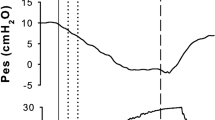Summary
The direct impact of changes in endtidal transpulmonary pressure (P′ L ) on phrenic (Phr) activity has been investigated in 6 cats anaesthetized with pentobarbital or ketamine. Rapid changes inP′ L were accomplished by steplike changes in tracheal pressure (P tr ), i.e., fromP tr =−12, −6, +6 and +9 cmH2O toP tr =0, and reversely. Phr activity was determined 0.2 and 0.4 s after the onset of Phr activity. This analysis was carried out for a few breaths immediately preceding and following theP tr change, and the results forP tr =0 were used as a reference. Oppositely directed steps inP tr , e.g., fromP tr =0 toP tr =+6 and, reversely, fromP tr =0 toP tr =+6 toP tr =0 toP tr =0, caused equal but opposite changes in Phr activity. Phr activity decreased with increasingP′ P tr =0 toP′ L , and this decrease amounted to 15% and 12% for each cmH2O increase inP′ L at 0.2 and 0.4 s respectively. These results imply that changes inP′ L especially affect Phr activity early in inspiration. The results also show that Phr activity in the initial phase of inspiration strongly depends onP′ L . Inhibition of inspiration facilitatory neurons by slowly adapting stretch receptors may be the kernel of the underlying mechanism of our findings.
Similar content being viewed by others
References
Adrian ED (1933) Afferent impulses in the vagus and their effect on respiration. J Physiol (Lond) 79:332–358
Armstrong DJ, Luck LC (1974) A comparative study of irritant and type J receptors in the cat. Respir Physiol 21:47–60
Asmussen E (1964) Muscular exercise. In: Fenn WO, Rahn H (eds) Handbook of physiology, Sect 3, Respiration, vol 2. Am Physiol Soc, Washington, DC, pp 939–978
Bartoli A, Cross BA, Guz A, Jain SK, Noble MIM, Trenchard DW (1974) The effect of carbon dioxide in the airways and alveoli on ventilation; a vagal reflex studied in the dog. J Physiol 240:91–109
Citterio G, Piccoli S, Agostoni E (1985) Breathing pattern and diaphragm EMG after SO2 in rabbit intraor extrathoracic airways. Respir Physiol 59:169–183
Cohen MI (1979) Neurogenesis of respiratory rhythm in the mammal. Physiol Rev 59:1105–1173
Cohen MI, Feldman JL (1977) Models of respiratory phase-switching. Federation Proc. 36:2367–2374
Coleridge HM, Coleridge JCG, Banzett RB (1978) II Effect of CO2 on afferent vagal endings in the canine lung. Respir Physiol 34:135–151
Davis HL, Fowler WS, Lambert EH (1956) Effect of volume and rate of inflation and deflation on transpulmonary pressure and response of pulmonary stretch receptors. Am J Physiol 187:558–566
Euler C von, Trippenbach T (1976) Excitability changes of the inspiratory off-switch mechanism tested by electrical stimulation in nucleus parabrachialis in the cat. Acta Physiol Scand 97:175–188
Green JF, Sheldon MI (1983) Ventilatory changes associated with changes in pulmonary blood flow in dogs. J Appl Physiol REEP 54:997–1002
Milic-Emili J, Henderson JAM, Dolovich MB, Trop D, Kaneko K (1966) Regional distribution of inspired gas in the lung. J Appl Physiol 21:749–759
Mills JE, Sellick H, Widdicombe JG (1969) Activity of lung irritant receptors in pulmonary micro-embolism, anaphylaxis and drug-induced bronchoconstrictions. J Physiol 203:337–357
Paintal AS (1973) Vagal sensory receptors and their reflex effects. Physiol Rev 53:159–227
SantAmbrogio G (1982) Information arising from the tracheobronchial tree of mammals. Physiol Rev 62:531–569
West JB (1965) Topographical distribution of blood flow in the lung. In: Fenn WO, Rahn H (eds) Handbook of physiology, vol 2, Section 3, Respiration. Am Physiol Soc, Washington DC, pp 1437–1451
Widdicombe JG (1964) Respiratory reflexes. In: Fenn WO, Rahn H (eds) Handbook of physiology, vol 1, Sect 3, Respiration. Am Physiol Soc, Washington DC, pp 585–630
Younes MK, Remmers JE, Baker J (1978) Characteristics of inspiratory inhibition by phasic volume feedback in cats. J Appl Physiol: REEP 45:80–86
Author information
Authors and Affiliations
Rights and permissions
About this article
Cite this article
Luijendijk, S.C.M., Kelly, G. & Trippenbach, T. Transpulmonary pressure and phrenic activity in early inspiration. Europ. J. Appl. Physiol. 58, 208–213 (1988). https://doi.org/10.1007/BF00636628
Accepted:
Issue Date:
DOI: https://doi.org/10.1007/BF00636628




